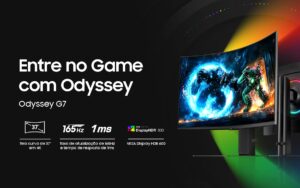
Nowadays, digital privacy has become an increasingly important issue, so much so that some protection measures may seem a bit “exaggerated” to many. This is the case with Microsoft’s new patent, which reveals advanced technology to protect your screen from prying or dangerous eyes.
The company recently published a patent describing the use of eye-tracking technology to mask all parts of the screen that the user is not actively looking at. Check out the details below.
Read too:
Microsoft requires its employees in China to use only iPhones
Proton launches alternative program to Google Docs and Microsoft Word
Microsoft patent uses eye-tracking technology
Obviously, it is very uncomfortable to use the computer with people nearby watching what you are doing at all times, and in some places this can even be a risk if there is access to important information such as personal and banking data.
Although it is ideal not to access bank accounts and other sensitive information in public places, some companies are already looking for solutions to make it possible to do so in a more secure way. Some companies are now selling physical privacy films, which are placed over the screen so that it becomes unreadable from certain oblique angles.
Microsoft wants to take this protection to another level, more specifically at the software level. The company has revealed a patent that describes a technique in which a webcam or other sensor tracks the user’s gaze.
This tracking happens because the idea is to scramble or blur the entire area of the screen that is not exactly where the user is looking. In this way, by taking away that small space, all the content on the screen becomes illegible to anyone nearby or passing by at that moment. As the user’s gaze moves across the screen, the clear area also moves, maintaining privacy around any part of the screen that is not being actively used.
But it’s worth noting that this idea isn’t new or unprecedented. AMD’s Privacy View tool also proposes something very similar, using eye tracking to darken or blur the entire screen, except for the region the user is currently looking at. This creates a spotlight effect where only the part of the screen being examined is visible.
Technique limits reading
But not everything is perfect, and Microsoft itself makes it clear that this technology can make the reading experience somewhat uncomfortable and fragmented.
“For a typical reader, the brain uses peripheral information during the reading process to anticipate the structure of sentences and paragraphs and maintain a natural reading speed,” says the patent. “Removing this information creates an uncomfortable and less efficient reading experience.”
To try to solve this problem, or at least mitigate it, they revealed that the software would use “gaze prediction techniques” to anticipate when and to which part of the screen the user’s gaze will move. This way, the tool could use these predictions to follow the user’s reading process in a more natural way. The edges of the “spotlight” would also be softened to mimic the natural peripheral vision of humans, which starts out clear and gets blurrier in the far corners.
But is all this effort necessary?
It’s obviously very important to maintain privacy and avoid prying eyes, but is this “visual hacking” really such a big or exaggerated risk? Few studies on the subject actually conclude that it’s a problem, and two of the ones that have are somewhat debatable.
That’s because both were sponsored by 3M, a company that manufactures and sells privacy filters. In fact, at the end of the 2021 study, they don’t even hide this, making a very clear recommendation to buy these filters. Aside from these studies, there is currently little evidence that visual hacking is frequently used to access other people’s data.
Of course, you need to be careful about this, but the truth is that most people at your work or who share a waiting room with you are not that interested in looking at your computer screen. Not that visual hacking doesn’t happen, but you still need to be careful and especially avoid showing this type of data when you are in a public place.
Furthermore, for now the technology is still a patent, which means there is no guarantee that the tool will actually become a real product.
Fonte: extremetech
Source: https://www.hardware.com.br/noticias/patente-da-microsoft-evita-curiosos-ao-borrar-as-partes-da-tela-que-voce-nao-esta-olhando.html


